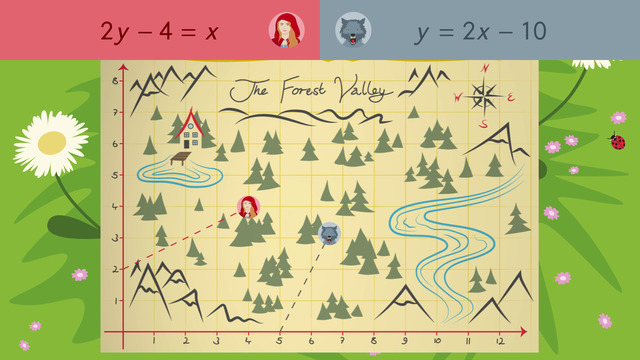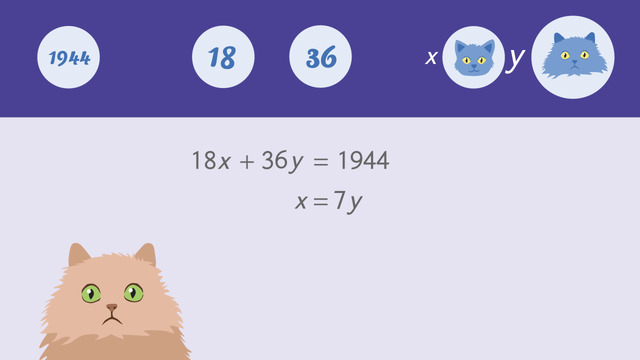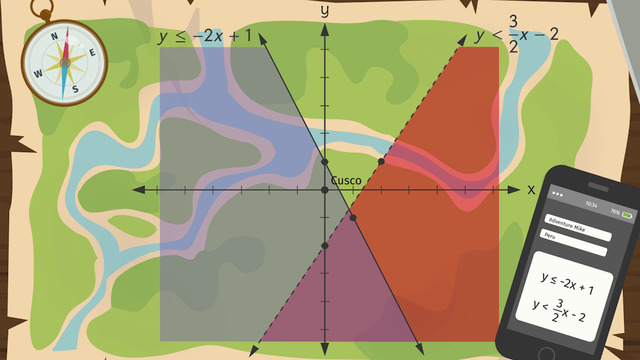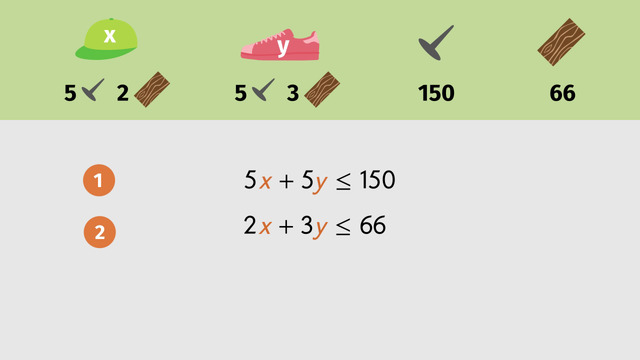Solving Systems of Equations by Graphing


Basics on the topic Solving Systems of Equations by Graphing
A system of equation is two or more equations with the same variables. To determine the point where the equations meet, the solution to the system, there are several methods: graphing, substitution, and elimination.
This video investigates how to use graphs to solve systems of equations. To determine where lines will meet on the coordinate plane (coordinate grid), manipulate each equation in the system, so it is written in slope-intercept form, y = mx + b. You can do this by isolating the y-value or the vertical coordinate.
Now using information from the equations written in slope-intercept form, you can graph the lines. Remember b is the y-intercept, and m is the slope or the rise over the run. First, mark the y-intercept, then using the slope value, you can mark a couple other points on the line and last connect the dots to draw a line. Do this for every equation in the system. The point where the lines intersect is the solution to the system and also the ordered pair that will satisfy all the equations in the solution.
How can a system of equations be useful in the real world? Well imagine you want to accidentally bump into someone, if you knew the equation of their path and the equation of your path… To learn more about this topic, watch the video.
Solve systems of equations to find solutions to problems.
CCSS.MATH.CONTENT.HSA.REI.C.5
CCSS.MATH.CONTENT.HSA.CED.A.3
Transcript Solving Systems of Equations by Graphing
Red Riding Hood and the Wolf are both walking through the forest. To figure out if and where they will meet we can solve a system of equations by graphing.
Let's look at a map of the forest. Red Riding Hood starts here and is walking in this direction. The Wolf starts here and is walking in this direction. It looks like they will meet at some point, but lets take a closer look using math.
When you look at the map, you can see that it looks like a cartesian coordinate system.
Red Riding Hood's path is along the line 2y - 4 = x. The Wolf's path is along the line y = 2x - 10. As you can see, the equation for the Wolf's path is already in slope-intercept form, so we can graph it easily. Let's transform the equation of Red Riding Hood into slope-intercept form as well.
Transforming Equations into Slope-Intercept Form
Slope-intercept form is y = mx + b. The first step in transforming this equation into slope-intercept form is to add 4 to both sides. Now you have 2y = x + 4. It is almost in slope-intercept form.
You just need to move the 2 in front of the y. You can do this by dividing by 2 on both sides. This reduces to y = 1/2 x + 2. Now the equation is in slope-intercept form.
Solving Equations by Graphing
Let's graph the lines. Red Riding Hood's equation is y = 1/2 x + 2. This means that the slope is 1/2 and the y-intercept is at (0, 2).
First, let's plot the y-intercept (0, 2). Now, because the slope represents rise over run, you can count up 1 and right 2 to plot the next point. You can keep counting up one and right two to plot more points.
The Wolf's equation is y = 2x - 10. This means that the slope is 2 and the y-intercept is at (0, -10). Since (0, -10) isn't visible on the graph let's plot our first point somewhere else.
The wolf looks close to where x = 5. When you plug in 5 for x the y-value is 0. Now you can plot the point (5, 0). Since the slope is 2 you can plot more points by moving up 2 and right one.
The two paths intersect at the point (8, 6). Whether or not Red Riding Hood and the Wolf will meet depends on how fast or slow they are both walking.
Imagine the Wolf's path could be described by y = x/2 + 3. Will they meet? Let's draw the graph.
The y-intercept is at (0, 3). Then we plot more points by counting up one and right two. The two lines are now parallel to each other so they will never intersect.
Now imagine the Wolf walked along the line y = 2x/4 + 4/2. Where will they meet? Let's draw the graph. The y-intercept is at (0, 2). To plot more points we count up 2 and right 4. As you can see the graphs are the same, which means there are infinitely many possible meeting points.
Let's get back to our first scenario. Red Riding Hood and the Wolf are walking toward the intersection point. Red Riding Hood sees the Wolf and is shocked for a split second. Phew, it's only Jim heading to the same Halloween Party. So they decide to walk together.
Solving Systems of Equations by Graphing exercise
-
Describe how to graph $y=\frac12x+2$.
HintsYou only need two points to draw a line.
If the slope is given as a fraction $\large m=\frac kl$, you go $k$ steps up for a positive slope, or $k$ steps down for a negative slope, and then $l$ steps to the right.
To solve for the y-intercept, plug $x=0$ into the equation $y=\frac12x+2$.
SolutionIf an equation is in slope-intercept form, we can graph the line by following these steps:
- plot the y-intercept
- using the slope, plot another point
Let's have a look at the equation describing Red Riding Hood's path, $y=\frac12x+2$:
- The y-intercept is at $(0,2)$.
- Starting from this point, because the slope is $m=\frac {1}{2}$, we count up one and two to the right.
- We can draw a line that passes through the y-intercept and the new point, $(2,3)$.
-
Use a graph to show the paths of Red Riding Hood and the Wolf.
HintsFirst, if you know it, draw the y-intercept.
You need at least two points to draw a line.
If the slope is given as a fraction, for example $m=\frac23$, to find a point on the line, from the y-intercept, we can count up two and three to the right.
If the slope is a negative number, for example $m=-2$, to find a point on the line, instead of counting up, we count down two and one to the right.
SolutionRed Riding Hood's path can be described by $y=\frac12x+2$.
- The y-intercept is $(0,2)$.
- When we look at the slope $m=\frac12$, it shows us to count up one and two to the right, starting from the y-intercept.
- Then, we draw a line that passes through the y-intercept and the new point.
- The y-intercept is at $(0,-10)$. Because this point can't be plotted on the map, we need another point on the line. We substitute $5$ for $x$: $y=2\times 5-10=10-10=0$. So $(5,0)$ is one point on the line.
- A look at the slope $m=2$ tells us that we have to go up two and one to the right, starting from the y-intercept.
- Then, we draw a line that passes through the point $(5,0)$ and the new point.
-
Determine whether or not Red Riding Hood and her grandmother meet.
HintsLook for the y-intercepts of the lines.
Which parts of the equations would have to be the same for the lines to be parallel?
SolutionUse what you know of the y-intercept and slope to help you solve this problem.
- In two pictures you can see parallel lines. Lines can only be parallel if the slopes are the same. The slope of Red Riding Hood's path is $m=\frac12$, and the slope of her grandma's path is $m=2.5$. So the lines are definitely not parallel. Therefore, you can rule out those two pictures.
- There is one other picture where the two lines have the same y-intercept. But the y-intercept of Red Rinding Hood's path is $b=2$, and the y-intercept of her grandma's path is $b=-6$. So this can't be the right picture either.
- You are left with the picture on the right.
- Red Riding Hood's path is given by the equation $y=\frac12x+2$.
- With the y-intercept at $(0,2)$ and the slope $m=\frac12$, we can graph the line you can see on the right.
- Grandmother's path is given by the equation $y=2.5x-6$.
- The y-intercept is at $(0,-6)$. Because this point can't be seen on the map, we need another point of the line. If you plug in $4$ for $x$ it gives us $y=2.5\times 4-6=10-6=4$, so one point on the line is $(4,4)$.
- The slope is $m=2.5=\frac52$. You can see the graph of the line in the picture on the right.
In this picture we can also find the meeting point $(4,4)$. Let's check it by plugging in $4$ for $x$:
- Red Riding Hood: $y=\frac12\times 4+2=2+2=4$
- Grandmother: $y=2.5\times 4-6=10-6=4$ $\surd$
-
Decide if the lines have a point of intersection.
HintsPlug in $0$ for $x$. This gives you the y-intercept.
For example: $m=-\frac32$ shows us to count:
- three down
- two to the right.
Draw both lines into a coordinate system to figure out the intersection.
At the intersection point, both equations share the same x- and y-coordinates, so you can set the two equations equal and solve for x.
Solution- $y=2x-3$.
- $y=-\frac12x+2$.
In this picture you can also see the point of intersection $(2,1)$.
Let's check this point by plugging in $2$ for $x$:
- $y=2\times 2-3=4-3=1$
- $y=-\frac12\times 2+2=-1+2=1$ $\surd$
-
Describe how to change $2y-4=x$ into slope-intercept form.
HintsThe slope-inercept form is $y=mx+b$.
- $m$ is the slope
- $b$ is the y-coordinate of the y-intercept
The x-coordinate of the y-intercept is always $0$.
To manipulate the equation use opposite operations:
- The opposite operation of addition is subtraction, and vice versa.
- The opposite operation of multiplication is division, and vice versa.
Whatever you do to one side of the equation, you have to do to the other side.
SolutionTo graph a linear equation, it is helpful to manipulate the equation into slope-intercept form:
$y=mx+b$
- $m$ is the slope
- $b$ is the y-intercept
- adding $4$ leads to $2y=x+4$
- dividing by $2$ gives us the slope-intercept-form, $y=\frac12x+2$
-
Analyze whether or not the lines have a point of intersection with the line of $y=-\frac13x+2$
HintsInto one coordinate system, graph each equation in a different color.
The slope represents the steepness of a line.
If two lines have the same slope, the y-intercepts define whether they have an infinite amount of common points or none at all.
SolutionThe slope defines if two lines
- have a point of intersection
- are parallel and have no common points or
- are identical and have an infinite amount of common points
Two parallel lines have no common points at all.
Two identical lines have an infinite amount of common points.
Two lines with different slopes may have exactly one point of intersection.
- The line of $y=-\frac26x+1=-\frac13x+1$ is parallel to the one above, but not identical. The two lines don't have any common points.
- The line of $y=x-6$ has a point of intersection with the line above. .
- The line of $y=-\frac13x+\frac42=-\frac13x+2$ is identical to the one above.
$\begin{array}{rcr} -\frac13x+2&=&x-6\\ \color{#669900}{-x}&&\color{#669900}{-x}\\ -\frac43x+2&=&-6\\ \color{#669900}{-2}&&\color{#669900}{-2}\\ -\frac43x&=&-8\\ \color{#669900}{\times 3}&&\color{#669900}{\times 3}\\ -4x&=&-24 \end{array}$
Now we divide by $-4$ and get
$x=\frac{-24}{-4}=6$
But this is only the x coordinate of the point of intersection. We get the y coordinate by plugging in $x=6$ into either of the equations:
$y=6-6=0$
So, the point of intersection is at $S(6,0)$.
















